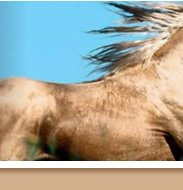![]()
![]()
![]()
![]()
![]()
![]()

![]()
![]()
![]()
![]()
![]()
Training a Horse with Separation AnxietyTo overcome the problems associated with separation anxiety, form a better bond with your horse so he respects and takes confidence in your leadership. By Camie Heleski Question: My 14-year-old First Level Thoroughbred gelding freaks out anytime he is around another horse and that horse leaves. For example, during a hack, we passed two horses in a fenced field. When we left them behind us, he started yelling, rearing and spinning to try to run back to them. I dismounted and had to lead him home. Otherwise, he is a lovely horse, and I would like to show him. Do you have any suggestions? Related Resources # Teach Your Horse to Tie # Leading Your Horse # More Ground Training Articles The Equine Collection # Teach Your Horse Perfect Manners - Kelly Marks Answer: If you evaluate these situations from the horse's perspective, they are not at all unusual. The horse takes great comfort in the instinct that there is safety in numbers. It is quite natural and common for a horse to form nearly immediate social bonds with other horses, particularly if the horse is in a venue that may make him a bit uneasy to start with, such as trail riding. Admittedly, your gelding is 14, but you may have to treat him like a "baby" for the time being. When your horse is acting as you described, it is indeed a dangerous situation, and you must take care not to get hurt. Dismounting and leading your horse is perfectly acceptable under the circumstances. I believe people get too hung up on the idea that they must ride their way through every bad or new scenario. Your horse will have more confidence in these situations if you are on the ground. For example, when I train horses to cross rivers, quite often I will dismount and lead the horse through it the first time or two. Yes, my boots get wet, but it is much easier to convince the horse that the river isn't a monster if I am willing to walk through it myself. Take care, though, that you know how to safely handle your gelding from the ground and that you are the dominant partner in your relationship with him, which I will explain a little later. But before that, when your horse throws these fits, make sure not to inadvertently reinforce them. If you allow yourself to become nervous, your horse sees this as reinforcement that he should be worried about the other horse leaving him. If you shorten the workout, your horse may see this as a reward for his poor behavior. No matter how much the quality of the workout may diminish, you must continue until the horse is again tuned into you. You can go back to simple movements for a while until he eventually returns his focus to you. If you have problems on the trail and feel more comfortable walking him back to the ring, continue working him in the ring until he has calmed down. The next time you go out on the trails, try taking a "babysitter" or older, quiet horse with you. As your horse gains confidence, the babysitter can be progressively farther away and eventually eliminated. One possible cause for your horse's lack of response to you during these situations is that he does not yet accept you as the dominant member of your partnership. Many horses go along willingly for their riders as long as everything is a comfortable environment, but as soon as the situation becomes unnerving, the horse is not willing to place complete confidence in his rider. Theoretically, a horse should form a surrogate bond with his rider that normally he would form with other horses in his heard. Watch other riders interact with their horses: You will see some people are obviously the more dominant member of the horse-person team, and you will see other pairs where it is clear the horse has the upper hand. To form a better bond with your horse, work on establishing his respect for your body language by developing on-the-ground skills, such as leading quietly and standing still while you groom and tack him. Longeing and round-pen exercises also develop the partnership you are seeking with your horse. Depending on your horse's personality, you may need to be more decisive or stern when you give him a command to halt on the lead line so he learns to listen and respond to you. Or you may need to approach what you want him to do more quietly and patiently--but still firmly--if he frightens easily. The input of a skilled trainer who can personally observe your interactions can be helpful. I do not think this problem will prohibit you from showing this horse, but it will take a great deal of patience, training and confidence on your part to overcome his anxiety. Wait to try showing until your horse is confident and listening well to you at home. Camie Heleski coordinates the Michigan State University Horse Management Program. She also teaches horse behavior, horsemanship, judging and exercise physiology at the university. She rides her Arabian/Trakehner at the lower levels of dressage in Mason, Michigan. This article is excerpted from Dressage Today, March 2002. |
![]()
![]()
ęCopyright 2025
Alhaja.net All rights reserved.
Unauthorized duplication in part or whole strictly prohibited by
international copyright law.
![]()



